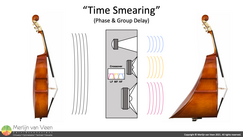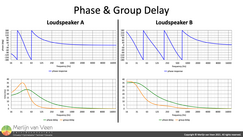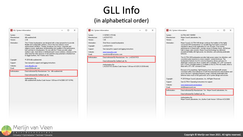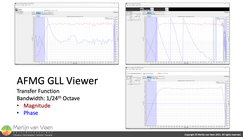 Figure 1Many seminar attendees are pretty indiscriminate at first about a loudspeaker's phase response. And tend to be shocked once you point out that typical full‑range loudspeakers (including studio monitors) with decreasing frequency are "smeared out" in time by a couple of dozen milliseconds (Figure 2).
Figure 1Many seminar attendees are pretty indiscriminate at first about a loudspeaker's phase response. And tend to be shocked once you point out that typical full‑range loudspeakers (including studio monitors) with decreasing frequency are "smeared out" in time by a couple of dozen milliseconds (Figure 2).
"The subjective effect of excessive group delay is a “loosening” of the bass or a “less dry” bass quality."
- Neumann -
Figure 1 shows an artistic impression of the increasing delay with decreasing frequency. As you go down in frequency, the sound becomes more sustained or "overhung". Something you would never tolerate of, e.g., mixing consoles (except by intention) or amplifiers. And if you feel a couple of dozen milliseconds is already slacking, buckle up for typical subwoofer values!
"But that is not tight!"
- Royal Conservatoire student that shall remain anonymous -
 Figure 2I find the attendees' cries of outrage quite amusing and my default reply is always: "Please keep calm! Simply because I gave you a ballpark figure, there is no reason to freak out; because — until now — you also never considered this a problem."
Figure 2I find the attendees' cries of outrage quite amusing and my default reply is always: "Please keep calm! Simply because I gave you a ballpark figure, there is no reason to freak out; because — until now — you also never considered this a problem."
You have been listening to loudspeakers that exhibit some degree of non‑linear phase shift, i.e., phase distortion, for most of your lives.
All joking aside — if from now on — you genuinely feel this typical range of values is excessive, you may want to look into this before your next gig for the following reasons:
- Phase Distortion
Change in the shape of the incoming waveform, that occurs when the phase response is — not linear — over the frequency range of interest. Where — loosely defined — excessive phase distortion can be thought of as "less tight" or "more loose". - Phase Compatibility
- Does the full‑range loudspeaker play nice with other full‑range loudspeakers of different brand, make, or model?
- Does the full‑range loudspeaker play nice with the subwoofer?
- Does the full‑range loudspeaker play nice with other full‑range loudspeakers of different brand, make, or model?
Assuming you can find a phase response to begin with...
Let the Hunt Begin
Finding a loudspeaker's phase response is easier said than done. The phase response is typically not included in product collateral such as specifications, data sheet, or manual. A manufacturer's proprietary prediction software may show the phase response. But in most cases, inquisitive users are burdened with finding the phase response themselves by conducting their own field measurements or through third parties. Figure 3
Figure 3 Figure 4Generic Loudspeaker Libraries (GLLs) are a place to start. Manufacturers typically create their own GLL files or may commission a third party. But, neither the GLL creation process nor the library's contents are independently policed (Figure 3).
Figure 4Generic Loudspeaker Libraries (GLLs) are a place to start. Manufacturers typically create their own GLL files or may commission a third party. But, neither the GLL creation process nor the library's contents are independently policed (Figure 3).
The entire venture is effectively based on an honor system which does not prevent some manufacturers from omitting data, e.g., leaving out the phase response by replacing it for a perfect flat line, or applying gratuitous smoothing (Figure 4).
The absence of phase responses in product collateral may explain — in part — why members of the community took matters into their own hands and started collecting the missing information themselves.
TracebookLittle over one year ago, Tracebook was launched in beta. Its mission statement reads:
Tracebook is an independent, non-profit initiative launched by members of the pro‑audio community, under the leadership of Nathan Lively. It is a public community that promotes the open exchange of loudspeaker system reference field data, measured by audio professionals for audio professionals.
- Tracebook -
Tracebook's FAQ contains several noteworthy entries:
- Tracebook — unambiguously — neither aspires nor pretends to facilitate "laboratory grade" data. Instead, it promotes complementary actionable reference field data, i.e. — data (within reasonable uncertainty) capable of being acted on — supplied by the community through multiple independent measurements and supported by a majority vote.
- Tracebook moderators audit all new incoming records for compliance with the Tracebook Measurement Procedure and each record must be approved by two unaffiliated moderators to minimize bias.
At the time of writing, the Tracebook community consists of nearly 900 members and lists 133 moderated and approved measurements.
Conclusion
Whether phase distortion is audible or not, is something everyone should experience for themselves. If you genuinely feel this is something that from now on should be worthy of your attention, "Speak now or forever hold your peace." as they say in holy matrimony.
For more information about the meaning of phase and group delay and what causes it, please consider reading Group Delay 101.
Note on Figure 1: This illustration is a recreation of an older image of unknown origin that I am no longer able to find on the internet. Should the original author take issue with this recreation. Please have him or her contact me.
